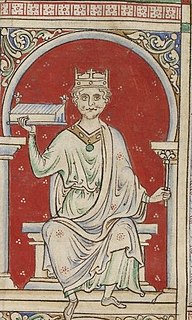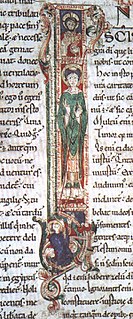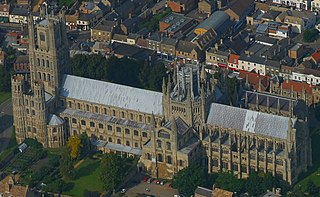Related Research Articles

William II was King of England from 26 September 1087 until his death in 1100, with powers over Normandy and influence in Scotland. He was less successful in extending control into Wales. The third son of William the Conqueror, he is commonly referred to as William Rufus, perhaps because of his ruddy appearance or, more likely, due to having red hair as a child that grew out in later life.

John Balliol, known derisively as Toom Tabard, was King of Scots from 1292 to 1296. Little is known of his early life. After the death of Margaret, Maid of Norway, Scotland entered an interregnum during which several competitors for the Crown of Scotland put forward claims. Balliol was chosen from among them as the new King of Scotland by a group of selected noblemen headed by King Edward I of England.
Ranulf Flambard was a medieval Norman Bishop of Durham and an influential government minister of King William Rufus of England. Ranulf was the son of a priest of Bayeux, Normandy, and his nickname Flambard means incendiary or torch-bearer, and may have referred to his personality. He started his career under King William I of England, probably in the compilation of the Domesday Book of 1086, as well as being the keeper of the king's seal. On the death of William I, Ranulf chose to serve the new king of England, William Rufus.

William de St-Calais was a medieval Norman monk, abbot of the abbey of Saint-Vincent in Le Mans in Maine, who was nominated by King William I of England as Bishop of Durham in 1080. During his term as bishop, St-Calais replaced the canons of his cathedral chapter with monks, and began the construction of Durham Cathedral. In addition to his ecclesiastical duties, he served as a commissioner for the Domesday Book. He was also a councillor and advisor to both King William I and his son, King William II, known as William Rufus. Following William Rufus' accession to the throne in 1087, St-Calais is considered by scholars to have been the new king's chief advisor.
Gerard was Archbishop of York between 1100 and 1108 and Lord Chancellor of England from 1085 until 1092. A Norman, he was a member of the cathedral clergy at Rouen before becoming a royal clerk under King William I of England and subsequently his son King William II Rufus. Gerard was appointed Lord Chancellor by William I, and he continued in that office under Rufus, who rewarded him with the Bishopric of Hereford in 1096. Gerard may have been with the king's hunting party when William II was killed, as he is known to have witnessed the first charter issued by the new king, Henry I of England, within days of William's death.
Geoffrey Rufus, also called Galfrid Rufus was a medieval Bishop of Durham and Lord Chancellor of England.

The House of Balliol was a noble family originating from the village of Bailleul in Picardy. They held estates in England, granted during the reign of King William Rufus. Through marriage, they had claims to the Throne of Scotland. One member of the family, John Balliol, was named King of Scotland after the disputed succession following extinction of the Dunkeld line. John was deposed, leading to the First War of Scottish Independence. His son, Edward Balliol, also briefly controlled the Scottish throne during the Second War of Scottish Independence. Edward had no issue, and the direct line went extinct with him.
Robert Bloet was Bishop of Lincoln 1093–1123 and Chancellor of England. Born into a noble Norman family, he became a royal clerk under King William I. Under William I's son and successor King William II, Bloet was first named chancellor then appointed to the See of Lincoln. Continuing to serve the king while bishop, Bloet remained a close royal councillor to William II's successor, King Henry I. He did much to embellish Lincoln Cathedral, and gave generously to his cathedral and other religious houses. He educated a number of noblemen, including illegitimate children of Henry I. He also was the patron of the medieval chronicler Henry of Huntingdon, and was an early patron of Gilbert of Sempringham, the founder of the Gilbertine monastic order.

Thomas of Bayeux was Archbishop of York from 1070 until 1100. He was educated at Liège and became a royal chaplain to Duke William of Normandy, who later became King William I of England. After the Norman Conquest, the king nominated Thomas to succeed Ealdred as Archbishop of York. After Thomas' election, Lanfranc, Archbishop of Canterbury, demanded an oath from Thomas to obey him and any future Archbishops of Canterbury; this was part of Lanfranc's claim that Canterbury was the primary bishopric, and its holder the head of the English Church. Thomas countered that York had never made such an oath. As a result, Lanfranc refused to consecrate him. The King eventually persuaded Thomas to submit, but Thomas and Lanfranc continued to clash over ecclesiastical issues, including the primacy of Canterbury, which dioceses belonged to the province of York, and the question of how York's obedience to Canterbury would be expressed.

Hervey le Breton was a Breton cleric who became Bishop of Bangor in Wales and later Bishop of Ely in England. Appointed to Bangor by King William II of England, when the Normans were advancing into Wales, Hervey was unable to remain in his diocese when the Welsh began to drive the Normans back from their recent conquests. Hervey's behaviour towards the Welsh seems to have contributed to his expulsion from his see. Although the new king, Henry I wished to translate Hervey to the see of Lisieux in Normandy, it was unsuccessful.

Alan Rufus, alternatively Alanus Rufus (Latin), Alan ar Rouz (Breton), Alain le Roux (French) or Alan the Red, 1st Lord of Richmond, was a Breton nobleman, kinsman and companion of William the Conqueror during the Norman Conquest of England. He was the second son of Eozen Penteur by Orguen Kernev. William the Conqueror granted Alan Rufus a significant English fief, later known as the Honour of Richmond, in about 1071.
Ranulph I de Mortimer was a Marcher Lord from the Montgomery lands in the Welsh Marches. In England, he was Lord of Wigmore in Herefordshire. In Normandy, he was the Seigneur of St. Victor-en-Caux. Ranulph was the founder of the English House of Mortimer of Wigmore. He acquired Wigmore Castle after William Fitz Osbern's son Roger de Breteuil joined the Revolt of the Earls of 1075. His lands and holdings in Herefordshire and Shropshire were granted to him by William the Conqueror before 1086.
Odo was Count of Troyes and of Meaux from 1047 to 1066, then Count of Aumale from 1069 to 1115. He was later also known as the count of Champagne and as Eudes II of Troyes.
William Warelwast was a medieval Norman cleric and Bishop of Exeter in England. Warelwast was a native of Normandy, but little is known about his background before 1087, when he appears as a royal clerk for King William II. Most of his royal service to William was as a diplomatic envoy, as he was heavily involved in the king's dispute with Anselm, the Archbishop of Canterbury, which constituted the English theatre of the Investiture Controversy. He went several times to Rome as an emissary to the papacy on business related to Anselm, one of whose supporters, the medieval chronicler Eadmer, alleged that Warelwast bribed the pope and the papal officials to secure favourable outcomes for King William.
Bernard I de Balliol, the second-known-ruling Balliol of his line, was a twelfth-century Anglo-Picard baron based for much of his time in the north of England, as well as at Bailleul-en-Vimeu close to Abbeville in northern France. He was the nephew and next known successor of Guy I de Balliol, the first Balliol in England.
Guy II de Balliol was probably the second-eldest son of Bernard I de Balliol, Lord of Balliol and Barnard Castle. As his older brother Enguerrand predeceased their father, Guy succeeded when his father died sometime between 1154 and 1162. He died sometime on or before 1167, and was succeeded by his youngest brother Bernard II de Balliol.
Bernard II de Balliol was the fourth and youngest son of Bernard I de Balliol, lord of Balliol and Barnard Castle. Bernard appears to have succeeded his older brother Guy II de Balliol to the Balliol estates sometime between the early 1160s and 1167.

Hugh de Balliol, Lord of Bywell, Barnard Castle and Gainford, was an English nobleman. He was the son of Eustace de Balliol and Petronilla FitzPiers. Balliol was a supporter of King John of England during the Barons Wars of 1215–17.

Robert Despenser was a Norman officeholder and landholder in post-Conquest medieval England.
Hamo Dapifer was an Anglo-Norman royal official under both King William I of England and his son King William II of England. He held the office, from which his epithet derives, known in Latin as dapifer and in French seneschal, in English "steward", as well as the office of Sheriff of Kent.
References
- Barlow, Frank, William Rufus, (New Haven, 2000), ISBN 0-300-08291-6
- Stell, G. P., "Balliol, Bernard de (d. 1154x62)", Oxford Dictionary of National Biography, Oxford University Press, 2004 , accessed 24 Jan 2008